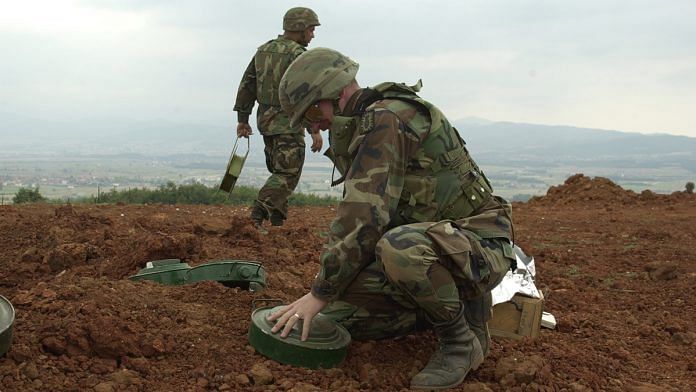New Delhi: The global casualty toll from landmines has doubled in the last five years, said a Landmine Monitor report, by the International Campaign to Ban Landmines. According to the report, the number of casualties was 3,457, a record low, in 2013 and the number doubled to 6,897 in 2018.
This steep rise is due to armed conflicts in Afghanistan, Syria and Malia and improvised explosive devices (IEDs), used by non-state actors like ISIS, have worsened the situation. Seventy-one per cent of the casualties were civilians out of which half were children, the Monitor report stated.
Delegates from over 164 countries gathered in Norway this week to discuss the goal of making the world landmine-free by 2025 at the Oslo Review Conference. They assessed the Anti-Personnel Mine Ban Convention, a 20-year-old pact signed by the countries. Prince Harry, who recently retraced his mother Princess Diana’s steps and visited the landmine fields in Angola, also teamed up with the convention.
on the @MineBanTreaty #OsloRevCon meeting in #Oslo https://t.co/3mmfjSvjO4
— Anti-Personnel Mine Ban Convention (@MineBanTreaty) November 26, 2019
“Myanmar, which is not part of the treaty, was the only country where government forces used anti-personnel mines over the past year,” noted an Al Jazeera report.
Since 1991, the stigma of mines and severe cases of maiming had prompted approximately 70 rebel groups around the world to not use them, said Stephen Goose, head of the arms division at Human Rights Watch.
“But clearly, what has happened with a number of non-state actors in recent years has gone against that trend,” he added, citing ISIS and Taliban in Afghanistan and Houthi rebels in Yemen.
Landmines used by Houthis in Yemen
The number of deaths in war-torn Yemen increased considerably in April this year. Human rights activists attributed it to the use of landmines across the country by the Houthis, a rebel group fighting the Yemeni government and the Gulf Alliance.
According to a report, landmines have led to the death of over 140 civilians, including 19 children, since 2018.
They have blocked the local population’s access to food and clean water and other aid in the country. Since explosives are strewn across farmlands and grazing fields, harvesting crops has also become difficult and a considerable amount of livestock has been lost.
Taliban minefields in Afghanistan
Mines, IEDs, artillery shells, mortar and cluster munitions contaminate approximately 1,100 square kilometres of soil across Afghanistan, stated a report by Relief Web that was released three weeks ago.
The economic value of farming lands, grazing areas and irrigation canals has also depreciated while swathes of arable land are becoming unusable due to these explosives.
“From tilled fields to pastures, irrigation waterways to dirt tracks, Afghanistan’s countryside remains a ticking time bomb,” the report added.






